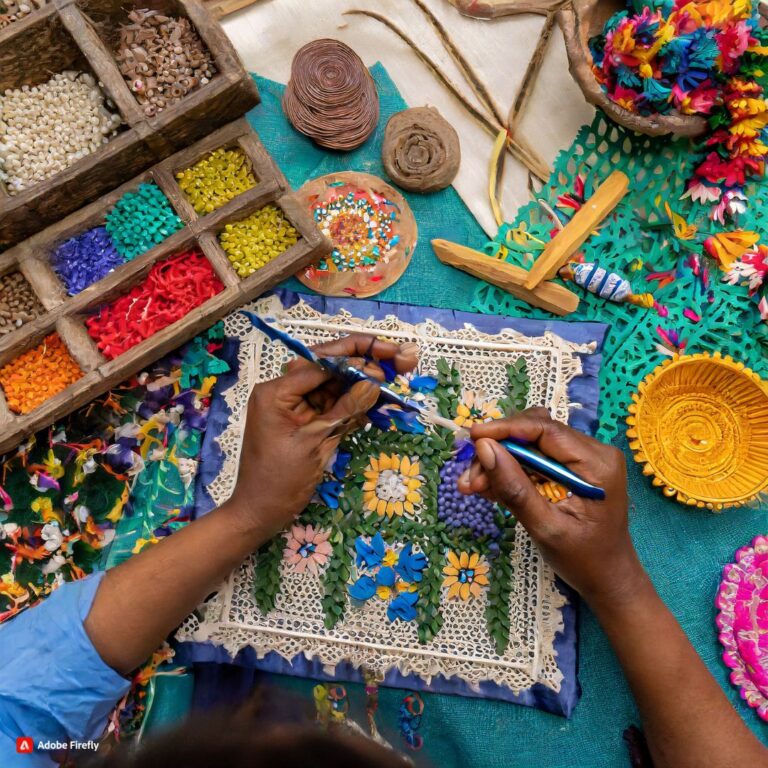
From Heart to Hand: The Story Behind Every Handmade Masterpiece
In the realm of handmade creations, each piece is more than just an object; it’s a testament to the artisan’s
Create a Space That’s Uniquely Yours

Create a Space That’s Uniquely Yours
Here each product is meticulously handcrafted by skilled artisans, blending traditional techniques with sustainable practices. We use high-quality, eco-friendly materials to create unique, timeless pieces. We ensure fair wages and supportive working conditions for our artisans, fostering ethical manufacturing. Every item tells a story of craftsmanship, culture, and creativity, bringing handmade excellence to your home.
Here each product is meticulously handcrafted by skilled artisans, blending traditional techniques with sustainable practices. We use high-quality, eco-friendly materials to create unique, timeless pieces. We ensure fair wages and supportive working conditions for our artisans, fostering ethical manufacturing. Every item tells a story of craftsmanship, culture, and creativity, bringing handmade excellence to your home.
We envision a world where traditional craftsmanship meets contemporary living. We are dedicated to bridging the gap between skilled artisans and appreciative customers, providing a platform that celebrates and sustains the rich heritage of handmade art. Our mission is to curate a diverse collection of unique, high-quality handcrafted products that bring beauty, authenticity, and cultural richness into every home. We strive to support and empower artisans by showcasing their work to a global audience, fostering sustainable practices, and preserving timeless crafts for future generations. Through our commitment to excellence and ethical trade, we aim to create meaningful connections and enrich lives with the artistry of handmade treasures.

In the realm of handmade creations, each piece is more than just an object; it’s a testament to the artisan’s

In today’s fast-paced consumer culture, where mass-produced items flood the market, there’s a growing appreciation for the unique charm and

In today’s fast-paced world, where mass-produced goods dominate the market, there’s a growing appreciation for the unique charm and authenticity
Handcraft, also known as handicraft or artisan craft. It represents a blend of culture, creativity, and craftsmanship. Unlike mass-produced goods, handcrafted items carry a unique charm and individuality, as each piece is made with personal attention and artistic expression. This practice encompasses a wide range of products, including textile, pottery, jewelries, woodwork, metalwork, glassware, and more.
Handcrafting is as old as human civilization itself. It began when early humans fashioned tools, clothing, and shelter using natural resources. In ancient civilizations such as Egypt, Mesopotamia, China, and India, artisans were highly respected for their skills, weaving, metalwork, and jewelry making. These crafts not only served practical purposes but also played significant roles in rituals, ceremonies, and trade.
Throughout history, handcrafting has been passed down through generations, preserving cultural traditions and heritage. In many indigenous communities, specific crafting techniques and designs are unique to particular tribes or regions. For example, Native American beadwork and pottery styles differ significantly among tribes, reflecting their distinct cultural narratives and spiritual beliefs. Banarasi and Kanchipuram silk carry historical and cultural significance, symbolizing identity and tradition.
Handcrafted items are typically made using locally sourced, natural materials such as clay, wood, metal, glass, fibers, and stones. The choice of material often depends on the environment and cultural context. Artisans use various techniques to transform these raw materials into beautiful creations.
In textile crafts, weaving, knitting, embroidery, and dyeing are common techniques. Each method involves intricate processes, requiring patience and skill. For example, handwoven carpets from Persia or Turkey are known for their complex patterns and vibrant colors, achieved through natural dyes and meticulous knotting techniques. Similarly, Japanese Shibori dyeing and Indian Bandhani involve intricate folding and binding methods to create unique patterns on fabric.
In pottery and ceramics, artisans mold clay by hand or using a potter's wheel, then fire it in a kiln to harden the form. Techniques like glazing, painting, and carving enhance the aesthetics of pottery. Renowned styles such as Chinese porcelain, Greek vases, and Mexican Talavera pottery showcase regional artistry and cultural symbolism.
One of the most captivating aspects of handcraft is its uniqueness. Different from factory-made items, no two handcrafted pieces are exactly alike. This individuality comes from the artisan’s personal touch, creativity, and improvisation. Even when following traditional patterns or techniques, artisans infuse their creations with their emotions, experiences, and cultural narratives, making each piece a work of art.
This uniqueness adds emotional value to handcrafted items, as they carry the maker's story and heritage. It also fosters a deeper connection between the creator and the consumer, who appreciates the skill, effort, and passion invested in each piece. In a world dominated by mass production and consumerism, handcrafted products stand out for their authenticity and personalized touch.
Handcrafting is not just an artistic pursuit but also a essential economic activity for many communities worldwide. It provides livelihood opportunities, especially for women and marginalized groups, promoting social empowerment and economic independence. In rural areas, craft industries are often a significant source of income, supporting local economies and sustainable development.
Consumers are now seeking alternatives to mass-produced goods, favoring handmade items that use sustainable materials and traditional techniques. This trend has revitalized the global handcraft industry, encouraging artisans to continue their craft and pass on their knowledge to future generations.
Besides its cultural and economic significance, the handcraft industry faces several challenges. Competition from machine-made products, changing consumer preferences, and the lack of market access are major obstacles. Additionally, the younger generation's disinterest in traditional crafts threatens the continuity of these age-old skills.
However, initiatives to preserve and promote handicrafts are gaining momentum. Governments, NGOs, and cultural organizations are working to provide training, financial support.
No account yet?
Create an Account